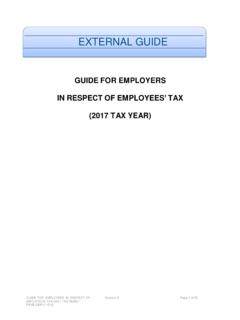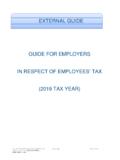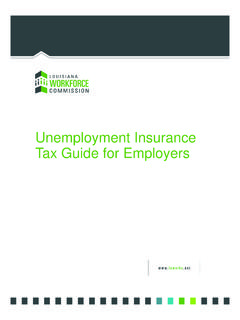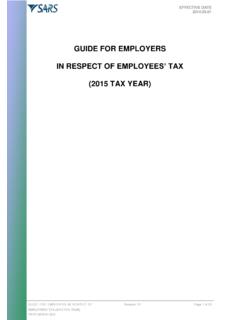Transcription of A Guide to Restroom Access for Transgender Workers
1 1-800-321- osha (6742) 1 Guide to Restroom Access for Transgender WorkersIntroductionThe Department of Labor s (DOL) Occupational Safety and Health Administration ( osha ) requires that all employers under its jurisdiction provide employees with sanitary and available toilet facilities, so that employees will not suffer the adverse health effects that can result if toilets are not available when employees need them. This publication provides guidance to employers on best practices regarding Restroom Access for Transgender Workers . osha s goal is to assure that employers provide a safe and healthy working environment for all employees. Understanding Gender IdentityIn many workplaces, separate Restroom and other facilities are provided for men and women.
2 In some cases, questions can arise in the workplace about which facilities certain employees should use. According to the Williams Institute at the University of California-Los Angeles, an estimated 700,000 adults in the United States are Transgender meaning their internal gender identity is different from the sex they were assigned at birth ( , the sex listed on their birth certificate). For example, a Transgender man may have been assigned female at birth and raised as a girl, but identify as a man. Many Transgender people transition to live their everyday life as the gender they identify with. Thus, a Transgender man may transition from living as a woman to living as a man.
3 Similarly, a Transgender woman may be assigned male at birth, but transition to living as a woman consistent with her gender identity. Transitioning is a different process for everyone it may involve social changes (such as going by a new first name), medical steps, and changing identification documents. Why Restroom Access Is a Health and Safety MatterGender identity is an intrinsic part of each person s identity and everyday life. Accordingly, authorities on gender issues counsel that it is essential for employees to be able to work in a manner consistent with how they live the rest of their daily lives, based on their gender identity. Restricting employees to using only restrooms that are not consistent with their gender identity, or segregating them from other Workers by requiring them to use gender-neutral or other specific restrooms, singles those employees out and may make them fear for their physical safety.
4 Bathroom restrictions can result in employees avoiding using restrooms entirely while at work, which can lead to potentially serious physical injury or s Sanitation Standard Under osha s Sanitation standard ( ), employers are required to provide their employees with toilet facilities. This standard is intended to protect employees from the health effects created when toilets are not available. Such adverse effects include urinary tract infections and bowel and bladder problems. osha has consistently interpreted this standard to require employers to allow employees prompt Access to sanitary facilities. Further, employers may not impose unreasonable restrictions on employee use of toilet principle: All employees, including Transgender employees, should have Access to restrooms that correspond to their gender (6742) 2 Practices for Restroom Access for Transgender EmployeesMany companies have implemented written policies to ensure that all employees including Transgender employees have prompt Access to appropriate sanitary facilities.
5 The core belief underlying these policies is that all employees should be permitted to use the facilities that correspond with their gender identity. For example, a person who identifies as a man should be permitted to use men s restrooms, and a person who identifies as a woman should be permitted to use women s restrooms. The employee should determine the most appropriate and safest option for him- or best policies also provide additional options, which employees may choose, but are not required, to use. These include: Single-occupancy gender-neutral (unisex) facilities; and Use of multiple-occupant, gender-neutral Restroom facilities with lockable single occupant of the physical layout of a worksite, all employers need to find solutions that are safe and convenient and respect Transgender employees.
6 Under these best practices, employees are not asked to provide any medical or legal documentation of their gender identity in order to have Access to gender-appropriate facilities. In addition, no employee should be required to use a segregated facility apart from other employees because of their gender identity or Transgender status. Under osha standards, employees generally may not be limited to using facilities that are an unreasonable distance or travel time from the employee s Federal, State and Local Laws Employers should be aware of specific laws, rules, or regulations regarding Restroom Access in their states and/or municipalities, as well as the potential application of federal anti-discrimination laws.
7 The Equal Employment Opportunity Commission (EEOC), the Department of Justice (DOJ), DOL, and several other federal agencies, following several court rulings, have interpreted prohibitions on sex discrimination, including those contained in Title VII of the Civil Rights Act of 1964, to prohibit employment discrimination based on gender identity or Transgender status. In April 2015, the DOL s Office of Federal Contract Compliance Programs (OFCCP) announced it would require federal contractors subject to Executive Order 11246, as amended, which prohibits discrimination based on both sex and gender identity, to allow Transgender employees to use the restrooms and other facilities consistent with their gender identity.
8 Also in April 2015, the EEOC ruled that a Transgender employee cannot be denied Access to the common restrooms used by other employees of the same gender identity, regardless of whether that employee has had any medical procedure or whether other employees may have negative reactions to allowing the employee to do so. The EEOC held that such a denial of Access constituted direct evidence of sex discrimination under Title VII. The following is a sample of state and local legal provisions, all reaffirming the core principle that employees should be allowed to use the restrooms that correspond to their gender identity. Colorado: Rule of the Colorado regulations requires that employers permit their employees to use restrooms appropriate to their gender identity rather than their assigned gender at birth without being harassed or questioned.
9 3 CCR (revised December 15, 2014), available at more information refer to: Sexual Orientation & Transgender Status Discrimination Employment, Housing & Public Accommodations, Colorado Civil Rights Division, available at: : Guidance from the Delaware Department of Human Resource Management provides Delaware state employees with Access to restrooms that correspond to their gender identity. The guidance was issued pursuant to the state s gender identity nondiscrimination law. Delaware s policy also suggests: Whenever practical, a single stall or gender-neutral Restroom may be provided, which all employees may utilize. 1-800-321- osha (6742) 3 , a Transgender employee will not be compelled to use only a specific Restroom unless all other co- Workers of the same gender identity are compelled to use only that same Restroom .
10 For more information refer to: State of Delaware Guidelines on Equal Employment Opportunity and Affirmative Action Gender Identity, available at: District of Columbia: Rule 4-802 of the Municipal Regulations prohibits discriminatory practices in regard to Restroom Access . Individuals have the right to use facilities consistent with their gender identity. In addition, single-stall restrooms must have gender-neutral signage. Municipal Regulations 4-802, Restrooms and Other Gender Specific Facilities, available at: Iowa: The Iowa Civil Rights Commission requires that employers allow employees Access to restrooms in accordance with their gender identity, rather than their assigned sex at birth.
















